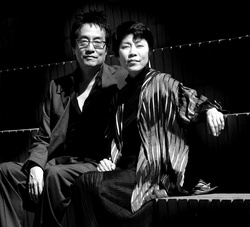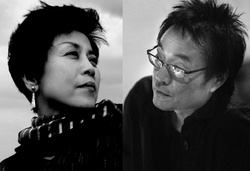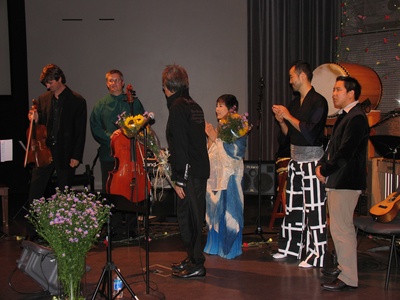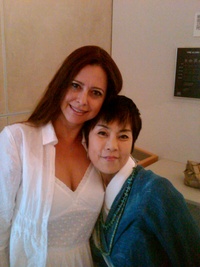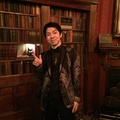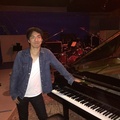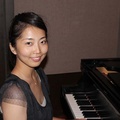The children of Japanese-Americans who emigrated to the United States generations ago commonly acquire knowledge of their cultural heritage through second-hand sources. Unfortunately, as time passes special meanings can be diluted, forgotten, or even lost.
For those who attended the concert held in the Tateuchi Democracy Forum at the Japanese American National Museum on August 13, 2011, savoring the flavor and sounds of Japanese culture became a first-hand experience through the authentic performance by Yoko Fujimoto of Japan. Singing since childhood, Fujimoto cannot remember a time when she did not sing. She took to the stage and lit up the room with her pure sounding notes perfectly in pitch.
The acoustically designed theater located at the museum was a perfect venue for an intimate concert. The program featured traditional folk music performed by Fujimoto who was accompanied by a line up of world-renowned musicians.
The audience was taken on a spiritual journey exploring the sounds and rhythms of Japanese music through an ensemble of voice, piano, Japanese flute, drums, percussion, vibes, cello and viola. One piece featured voice and ukulele. The musical arrangements were fresh and had a feel of improvisation without losing the roots of the music’s traditional feel.
This combination of the traditional story songs combined with modern improvisational smooth-jazz fusion sounds appealed to all ages and musical tastes bridging together generations to reflect on simple concepts such as nature, Japanese historical events, and life’s simplest pleasures. The charming anecdotes by Fujimoto in Japanese interpreted by her woodwind player/percussionist, Kaoru Watanabe, preceded each piece and encouraged further understanding of the lyrical message or lesson, and overall philosophical intention of the song.
With this set-up, one could close his or her eyes and adventure into the mindset and emotions on a magical journey through the tranquility and pureness of Fujimoto’s storytelling abilities and gift of her extraordinary vocal finesse. She is petite in stature and moves gracefully, but her voice is strong and powerful, and each sound conveys a specific meaning.
When composer/arranger Derek Nakamoto first listened to the sound of Fujimoto’s voice from a seat in the back of an auditorium, he knew she was something special and developed the idea of recording a CD of traditional folk melodies adapted into harmonies in a New Age style to form new hybrid music.
Nakamoto and Fujimoto have been collaborating ever since for over five years. In 2010 they recorded the CD Morisa Komorisa, and the transformation of the songs was well received internationally.
This positive reception is what prompted Nakamoto to invite Fujimoto to perform at the museum this year. Fujimoto performed several of the songs from that body of work. The balance between the traditional songs presented such as “Ho Hai” and the collection of Ainu Songs and the Classical and New Age arranged material was beautiful.
One of the highlights of the show was when Fujimoto magically sang the sweet and soothing melody of “Horanero Nennero.” In that moment she crossed cultural boundaries and entered into the emotional realm. The audience was totally engaged; I turned to my mother, who is American, and saw that she too was deeply moved by the beautiful and nostalgic melody.
The premise of recording the CD was to share Japanese culture and to remind us all that music is universal. Regardless of our differences, we can still communicate and eliminate linguistic and cultural gaps by talking about how we “feel” and how we are personally moved by musical expressions, sounds, and primordial rhythms set to songs within universal categories such as the earth, the sea, flowers, and animals, etc. Through music it is clear that we can create an open channel for discourse, finding common ground among humanity.
The mission statement of the museum and the Tateuchi Democracy Forum is based on the principle that “diversity and democracy are integrally related to each other.” By bringing this combination of musicians together to perform and relay Japanese history, poetry, and philosophy, the museum fulfilled its goals of promoting diversity and culture as a means to peace and tolerance.
After the show, I spoke with Fujimoto about how she felt about coming to Los Angeles to share her talent and folklore with the audience. She was eager to answer and stated that while performing she strives to connect deeply with her audience.
“Music is a way of communicating emotions and when I sing, I envision having a conversation with my audience. I'd like to feel that I am reaching out to each person and telling a story, or moving him or her with my voice in some way that reaches beyond words.”
She went on to say, “My ongoing wish is to use my voice to promote a message of peace, hope and harmony between all people. Even though different races and cultures may not understand our language, and we do not share the same religions, traditions, etc., through music we are able to communicate using our emotional channels; we can share joy and sadness; we can laugh together, and cry together."
When asked if she felt patriotic about sharing her music with other cultures, she responded, “I am proud and excited to come to the U.S. as an artistic representative of Japan and the traditional style of Japanese music. I want to express the beauty of Japan through my music."
The musical program of songs varied from the mysterious melodic vocal lines of “Owaiyare” driven by passionate drum beats and percussion that swept you home to the exotic island of Sado, to the peacefulness felt in the soft and pure lullaby of “Takeda no Komori -Uta.”
In a world of rapid globalization, people and cultures evolve. It is crucial that we do not lose sight of our roots and work to preserve the centuries of historical events that make us uniquely who we are. The way we can do this is through the promotion of the arts as a means to convey cultural heritage that can so easily be forgotten through modern evolution and globalization. We must embrace one another’s stories, joys, sadness, desires, positive characteristics, as well as our flaws in order to understand that we are all closely related.
Fujimoto has been performing for many years with the Japanese group “Kodo,” which performs worldwide to bridge those cultural gaps, and expose the beauty of Japanese traditions. “Kodo strives to both preserve and re-interpret traditional Japanese performing arts.”
Fujimoto will continue to tour with Kodo and make special appearances as a soloist whenever possible. One cannot help but wonder why we have not heard this jewel of a voice in an anime or film production to date. I asked her how she felt about Japan’s fame gained through anime productions. She answered, "It's a great thing that pop culture in Japan is able to cross over and communicate with different countries and cultures through the anime genre and that so many like the Japanese style of music."
I then asked her, “You are a serious singer. Would you ever consider singing a theme for TV or film in the pop vein?” She responded enthusiastically to the prospect of using her voice in other genres such as pop or TV and replied without hesitation: "Yes, of course I would like to do it!”
In my opinion, this particular voice out of a pool of professional voices is certainly apropos for anime and film, and it’s just a matter of time before talent meets opportunity. I can realistically see Fujimoto crossing international musical boundaries as a soloist with the continued musical direction demonstrated at the concert by Nakamoto.
This innovative new form of blending Japanese traditional music with modern instrumentation and Jazz harmonies has the potential for a new genre in mainstream international music. I look forward to following the progression of the Fujimoto/Nakamoto New Age/Jazz project.
For Japanese-Americans and all Angelenos who were present at the museum for this special concert, all found an escape into a natural world of Japan’s beauty, honesty and purity of heart. Fujimoto and Nakamoto’s rare talents should be celebrated every year at the museum.
The group was invited to perform by Koji Sakai of the Japanese American National Museum. His ongoing support and promotion of the duo and project made this performance possible. I know that I will be first to buy my ticket and take another ride into the fascinating realm of Japanese music, folklore and philosophy through a set of mindful transitions performed by Fujimoto, Nakamoto and this very impressive group of eclectic musicians. See you enthusiastically at next year’s Nisei Festival!
To hear some samples of Yoko Fujimoto’s music you may visit her homepage at: yokofujimoto.com
For more information on Derek Nakamoto please visit: dereknakamoto.com
More information on the group Kodo: kodo.or.jp
Japanese American National Museum: janm.org
© 2011 Rachelle Cano


